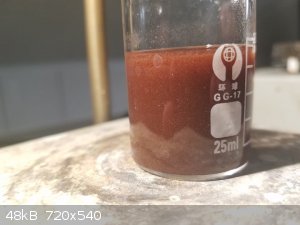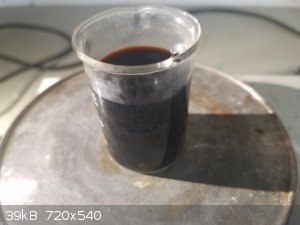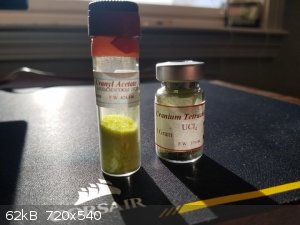Rhodanide
Hazard to Others
  
Posts: 348
Registered: 23-7-2015
Location: The 80s
Member Is Offline
Mood: That retro aesthetic
|
|
The Colors of Uranium
I've recently (last year or so) been dealing with the chemistry of Uranium, primarily in the +6 oxidation state. I've been trying to see what colors I
can get from various compounds. So far there have been a few interesting instances. Red seems to be a somewhat common color for some of the U(VI)
compounds I've encountered so far. Two compounds have been dark red in color, those being Uranyl Rhodizonate & Uranyl Ferrocyanide. The only one
I've been successful in isolating as a solid being the Ferrocyanide, as a dark red nearly black amorphous powder with a metallic luster, slightly
soluble in water. One compound has been yellow. When solutions of Uranyl acetate and KSCN are mixed, a yellow color is formed however I couldn't
isolate anything. Uranyl Acetate and Nitrate have been vibrant green, as expected.
One highly interesting compound I've made has been the complex of U(VI), likely as the Uranyl ion with the crown Ether 18-crown-6. 18c6 was dissolved
in CHCl3, and Uranyl Nitrate was dissolved in distilled water, giving a green solution. Upon mixing the two solutions I got phase
separation as expected. However, upon shaking the (closed, mind you) reaction vessel for about 1.5 minutes and letting the layers separate, I noticed
that the green color had moved to the bottom Chloroform layer, and the top aqueous layer had become colorless. Uranyl Nitrate is insoluble in
Chloroform, which disproves the claim that the color was simply the Uranyl Nitrate migrating phases. Separation of the organic layer gave a pale green
solution, which upon cooling to 0 C yielded pale green crystals in the bottom of the container, presumed to be the complex of the Uranyl
(UO22+) ion and 18c6. These crystals have not been isolated due to the fact that the amount is very small, and remain under
Chloroform at 0 C. No decomposition observed after 7 months at 0 C. I do have UCl4, and I'd love to do some chemistry with it. However, I
am extremely hesitant to do so because of the lack of information that I have on the compound (and most U(IV) compounds in general, besides
UO2) and the fact that it costs over $40 USD per gram of UCl4...
So! Have any of you had any experiences with Uranium chemistry? Any "alternate" colored compounds or complexes you've made or heard of? I'm eager to
know. I really wish more people would do chemistry with Uranium. Its chemistry is so rich!
Photo 1: Uranyl Ferrocyanide suspended in EtOH
Photo 2: Uranyl Ferrocyanide in aq solution
Photo 3: Uranyl Acetate & Uranium Tetrachloride side by side
  
|
|
|
Ubya
International Hazard
    
Posts: 1232
Registered: 23-11-2017
Location: Rome-Italy
Member Is Offline
Mood: I'm a maddo scientisto!!!
|
|
If i remember correctly uranium nitrate is soluble is ether, it's a propriety used to separate uranium via solvent extraction. So maybe it could be
soluble in chloroform? Try mixing chloroform and aqueous uranium nitrate, if it goes to the organic phase you could have a crown ether complex or more
probably just uranyl nitrate.
As for general uranium chemistry I was able to buy a few years ago 5g of uranyl acetate, but I never used it in anything yet, maybe in the future I'll
try to make a UO2 pellet
---------------------------------------------------------------------
feel free to correct my grammar, or any mistakes i make
---------------------------------------------------------------------
|
|
|
fusso
International Hazard
    
Posts: 1922
Registered: 23-6-2017
Location: 4 ∥ universes ahead of you
Member Is Offline
|
|
What's the cheapest U compound (per g of U, not the whole compound) one can get?
[Edited on 190411 by fusso]
|
|
|
Ubya
International Hazard
    
Posts: 1232
Registered: 23-11-2017
Location: Rome-Italy
Member Is Offline
Mood: I'm a maddo scientisto!!!
|
|
Quote: Originally posted by fusso  | What's the cheapest U compound (per g of U, not the whole compound) one can get?
[Edited on 190411 by fusso] |
well it still depends on the total price of the compound, metallic uranium should have a ratio 1:1 (uranium content:price), but samples run from 50 to
60€ per gram (on popular websites like ebay) but for example i payed 15€ for 5g of uranyl acetate, equivalent to 2.8g of uranium, so 5.35€ per
gram.
uranium has a really high atomic weight so, even a big molecule like acetate (2 of them) and 2 oxygen atoms (and 2 molecules of water as mine is the
dihydrate) the uranium is still more than half the weight.
maybe don't buy the iodate 
---------------------------------------------------------------------
feel free to correct my grammar, or any mistakes i make
---------------------------------------------------------------------
|
|
|
fusso
International Hazard
    
Posts: 1922
Registered: 23-6-2017
Location: 4 ∥ universes ahead of you
Member Is Offline
|
|
Quote: Originally posted by Ubya  | Quote: Originally posted by fusso  | What's the cheapest U compound (per g of U, not the whole compound) one can get?
[Edited on 190411 by fusso] |
well it still depends on the total price of the compound, metallic uranium should have a ratio 1:1 (uranium content:price), but samples run from 50 to
60€ per gram (on popular websites like ebay) but for example i payed 15€ for 5g of uranyl acetate, equivalent to 2.8g of uranium, so 5.35€ per
gram.
uranium has a really high atomic weight so, even a big molecule like acetate (2 of them) and 2 oxygen atoms (and 2 molecules of water as mine is the
dihydrate) the uranium is still more than half the weight.
maybe don't buy the iodate  |
Is the
acetate cheaper than nitrate (also per g of U)? And what make U compounds more expensive than silver metal (U is normally extracted as compounds and
Ag extracted as metal hence such comparison)?
|
|
|
Ubya
International Hazard
    
Posts: 1232
Registered: 23-11-2017
Location: Rome-Italy
Member Is Offline
Mood: I'm a maddo scientisto!!!
|
|
uranyl nitrate 394 g/mol (60% pure U)
uranyl acetate dihydrate 424g/mol (56% pure U)
each one has 1 atom of uranium so 238 g/mol. as you can see if you can find uranyl nitrate and uraniyl acetate for the same price buy the nitrate, it
has 4% more uranium.
as you can see the difference in percentage is not that much, that's why i said is more important the compound price.
---------------------------------------------------------------------
feel free to correct my grammar, or any mistakes i make
---------------------------------------------------------------------
|
|
|
fusso
International Hazard
    
Posts: 1922
Registered: 23-6-2017
Location: 4 ∥ universes ahead of you
Member Is Offline
|
|
Wait, what about simple oxides like UO2 & UO3? Are they cheaper than acetate/nitrate?
[Edited on 190411 by fusso]
|
|
|
Ubya
International Hazard
    
Posts: 1232
Registered: 23-11-2017
Location: Rome-Italy
Member Is Offline
Mood: I'm a maddo scientisto!!!
|
|
i don't know how to be clearer.
yes, in theory for the same mass uranium oxide should be cheaper than acetate/nitrate, but by this theory uranium metal should be cheaper than any of
its compounds.
the price itself is not really dependant on the amount of uranium in the compound, but depends on other factors, mostly the fact that uranium is not
used much in everyday life.
ironically 1 pound if uranium is quoted at 28$
but you'll never find as a citizen someone that sells you 500g of uranium metal for around 30$
---------------------------------------------------------------------
feel free to correct my grammar, or any mistakes i make
---------------------------------------------------------------------
|
|
|
fusso
International Hazard
    
Posts: 1922
Registered: 23-6-2017
Location: 4 ∥ universes ahead of you
Member Is Offline
|
|
So if lower demand means lower price why isn't this true for U?
|
|
|
unionised
International Hazard
    
Posts: 5102
Registered: 1-11-2003
Location: UK
Member Is Offline
Mood: No Mood
|
|
Logically, the uranium ore from which the others are made must be the cheapest form in which to buy uranium
|
|
|
Ubya
International Hazard
    
Posts: 1232
Registered: 23-11-2017
Location: Rome-Italy
Member Is Offline
Mood: I'm a maddo scientisto!!!
|
|
because the offer is even lower for "normal" citizens
how many people do you know that want some uranium? very few
how many people do you think are able to supply uranium compounds to people like us? fewer still
people can't make a living selling 5g of uranyl nitrate on ebay to just a few interested guys, so the price goes up, a lot.
if there are like only 5 guys wanting to buy a compound you made (and it was quite hard to make or needed special equipment), and you are the only one
providing it, would you sell it for dirt cheap or are you going to pump the price to make some profit?
[Edited on 11-4-2019 by Ubya]
---------------------------------------------------------------------
feel free to correct my grammar, or any mistakes i make
---------------------------------------------------------------------
|
|
|
Boffis
International Hazard
    
Posts: 1836
Registered: 1-5-2011
Member Is Offline
Mood: No Mood
|
|
Have you thought about buying a specimen of pitchblende. The massive earthy variety occasionally pops up on ebay in the US though anything radioactive
seems to have disappeared from the European sites. The crystals and glossy botryoidal types of pitchblende are always expensive but I have seen stuff
from Colorado and Utah sandstone type deposits quite cheap.
|
|
|
woelen
Super Administrator
        
Posts: 7976
Registered: 20-8-2005
Location: Netherlands
Member Is Offline
Mood: interested
|
|
I have some finely ground pitchblende (a dark green powder, formula is U3O8).
This stuff dissolves in nitric acid, giving a bright yellow/green solution and formation of NOx. The nitric acid oxidizes the U3O8.
Some residue remains, probably insoluble silica matter.
The bright yellow/green solution forms a golden yellow precipitate with NaOH. I don't know what it is. Some websites write about UO3, others about
Na2U2O7.
I also added some H2O2 to a bright yellow/green solution of uranyl nitrate (which was partly neutralized with NaOH to make it less acidic). This
produces a very pale yellow precipitate. According to literature, this is a mixed weak acid, with hydrogenperoxide in its crystal lattice,
UO2(OH)2.H2O2. This pale yellow compound is quite interesting. It could be used to purify uranium solutions, made from pitchblende. It precipitates,
even from not too strongly acidic solutions, while other metals remain in solution at low pH.
I, however, only have a very limited amount of uranium oxide, so I could not do experiments on a larger scale in which it is possible to isolate a
decent amount of the peroxide, without excessive mechanical losses.
|
|
|
DraconicAcid
International Hazard
    
Posts: 4278
Registered: 1-2-2013
Location: The tiniest college campus ever....
Member Is Offline
Mood: Semi-victorious.
|
|
Weird. I could have sworn that a specific book in my possession had a detailed description of what happened to an aqueous solution of a uranium salt
when reduced, how it would turn a dirty green (a mixture of +2 and +3), which could easily be oxidized to an apple green (pure +3). Rechecking that
book tells me that U+3 is red and the description I remember is nowhere to be seen. Memory once again makes a fool of me.
Please remember: "Filtrate" is not a verb.
Write up your lab reports the way your instructor wants them, not the way your ex-instructor wants them.
|
|
|
Deathunter88
National Hazard
   
Posts: 507
Registered: 20-2-2015
Location: Beijing, China
Member Is Offline
Mood: No Mood
|
|
Autunite in my opinion is still the best and cheapest source for uranium compounds that is readily accessible to the amateur. I made an extraction
tutorial if anyone's interested: https://www.youtube.com/watch?v=1NmY-emT7R0
|
|
|
Ubya
International Hazard
    
Posts: 1232
Registered: 23-11-2017
Location: Rome-Italy
Member Is Offline
Mood: I'm a maddo scientisto!!!
|
|
I saw it  currently in my projects playlist. Just need to organize a vacation
in czech Republic or in the alps near a few mines, totally not to dig as much uranium as I can fit in a car no no currently in my projects playlist. Just need to organize a vacation
in czech Republic or in the alps near a few mines, totally not to dig as much uranium as I can fit in a car no no
---------------------------------------------------------------------
feel free to correct my grammar, or any mistakes i make
---------------------------------------------------------------------
|
|
|
phlogiston
International Hazard
    
Posts: 1375
Registered: 26-4-2008
Location: Neon Thorium Erbium Lanthanum Neodymium Sulphur
Member Is Offline
Mood: pyrophoric
|
|
The periodic video's channel now has a video showing compounds of berkelium, curium, plutonium, neptunium and americium, as solids and/or in
concentrations high enough that you can actually see their colors.
Interesting.
-----
"If a rocket goes up, who cares where it comes down, that's not my concern said Wernher von Braun" - Tom Lehrer |
|
|
andy1988
Hazard to Others
  
Posts: 135
Registered: 11-2-2018
Location: NW Americus ([i]in re[/i] Amerigo Vespucci)
Member Is Offline
Mood: No Mood
|
|
This was a thought provoking video on possible chemistry uses starting around 3:30.
Quote: Originally posted by Ubya  | Just need to organize a vacation in czech Republic or in the alps near a few mines, totally not to dig as much uranium as I can fit in a car no
no |
I've visited long abandoned uranium mines in Utah on vacation, abandoned because the price plummeted. Yellow and green ores. I'd heard the miners
largely died of lung cancer, due to inhalation of radon gas. One mine was inside a mesa, with three circular entrances sealed with cement by the U.S.
gov, yet the side of the mesa collapsed and through a narrow fissure you could see ~15' timbers holding up the roof of a large room. I didn't dare go
in, looked dangerous, and also the radon gas issue. I filled a jar full of dark dirty green and light apple green ore from scraps laying around. But I
lost the jar when in a moment of drunk inspiration I decided to bury it rather than store inside my residence, and I have no clue where I'd buried it
because I was drunk! I'm not being coy I seriously couldn't find it again digging around to show a friend.
But seriously, great vacation idea, probably the best I'd been on with geologist friends.
|
|
|
Rhodanide
Hazard to Others
  
Posts: 348
Registered: 23-7-2015
Location: The 80s
Member Is Offline
Mood: That retro aesthetic
|
|
I've got Pitchblende, about four or five rocks of it. The largest is several hundred grams and extremely hot. As for Uranyl Nitrate, it's said to not
be soluble in CHCl3, but that's coming from Wikipedia which doesn't mean much but still. My other "hot" materials include an old fiestaware plate with
UO3 glaze, that's extremely hot as well! I've got UO2 as well, and ThO2 that I extracted from Thoriated Tungsten welding rods by digestion in 35%
H2O2. It's a white powder that's mildly radioactive. U and Th seem to be the only accessible Actinides to the public. It's unfortunate, really.
|
|
|
woelen
Super Administrator
        
Posts: 7976
Registered: 20-8-2005
Location: Netherlands
Member Is Offline
Mood: interested
|
|
Pitchblende is mainly U3O8. This is an ionic oxide and definitely not soluble in whatever organic solvent you may throw at it.
My own experience is that it also is not soluble in dilute acids like H2SO4 and HCl. It does dissolve in hot concentrated nitric acid. This gives a
bright yellow/green solution and some sand-like material remains undissolved.
Maybe I should make a web page about uranium chemistry, it is missing on my website. If I want to do some more experimenting, I might have to get some
of the autunite. It is on eBay, but quite expensive. People easily bid $10 for a little piece of about 1 gram.
|
|
|
phlogiston
International Hazard
    
Posts: 1375
Registered: 26-4-2008
Location: Neon Thorium Erbium Lanthanum Neodymium Sulphur
Member Is Offline
Mood: pyrophoric
|
|
Sulfuric acid is used commercially to leach uranium from pitchblende and other ores, and should be able to solubilize 90%+of the uranium from it.
However, an oxidiser is necessary. Manganese dioxide, hydrogen peroxide and chlorate are used for this purpose.
Most papers suggest that the added oxidiser does not oxidise uranium directly, but rater U is oxidised to its 6+ oxidation state by Fe3+, and the
added oxidiser re-oxidises Fe2+. Becase nearly all ores contain at least some iron, adding iron is hardly ever necessary (but won't hurt).
I have a little piece of Pitchblende that I found in the erzgebirge (Sachsen, Germany) during a summer holiday. Not planning to do any chemistry with
it. I keep it as part of my mineral collection.
-----
"If a rocket goes up, who cares where it comes down, that's not my concern said Wernher von Braun" - Tom Lehrer |
|
|